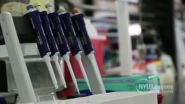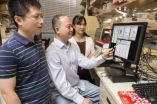(Press-News.org) LA JOLLA, CA—August 14, 2014—Chemists led by Nobel laureate K. Barry Sharpless at The Scripps Research Institute (TSRI) have used his click chemistry to uncover unprecedented, powerful reactivity for making new drugs, diagnostics, plastics, smart materials and many other products.
The new SuFEx—Sulfur Fluoride Exchange—reactions enable chemists to link molecules of their choice together using derivatives of a common commercial chemical considered essentially inert. The Sharpless team made this chemical reliably and predictably reactive. Astonishingly, acid-base constraints are rarely a concern, though they are central to nature's chemistry and an enormous hurdle for chemists. The stabile linkers are also non-polar and can enter cells, so have potential for crossing the blood-brain barrier.
Consequently, SuFEx gives easy access to an entire, unexplored galaxy within the chemical universe.
"This is a new, emergent phenomenon," said Sharpless, the W.M. Keck Professor of Chemistry and member of the Skaggs Institute for Chemical Biology at TSRI.
Click chemistry, conceived in the mid-90s as a method for discovering new and improving existing chemical reactivity, became universally used in the chemical sciences after the 2002 discovery of copper-catalyzed azide-alkyne cycloaddition (CuAAC). Now SuFEx is the second "perfect" click reaction to be discovered at TSRI.
The findings by Sharpless and his colleagues were reported online ahead of print by the international chemistry journal Angewandte Chemie.
Chemistry that Clicks
Sharpless shared the 2001 Nobel Prize in Chemistry for his discovery and development during the 80s of asymmetric catalytic reactions. Nature routinely makes "handed" molecules like DNA, which is like a spiral staircase you enter on the left, but chemists could not reliably make left- or right-handed molecules. The Sharpless asymmetric reactions gave chemists that gift with general reactions that made either left- or right-handed products at will.
To a younger generation of scientists, however, Sharpless is famous for click chemistry. Conceived at TSRI in the mid-90s, it is Sharpless's modular approach for quickly discovering new, or improving existing, chemical function. True click reactions have guaranteed reliability and are environmentally "green," proceeding in water, under normal atmospheric conditions, and without significant byproducts. After the 2002 discovery of the copper-catalyzed azide-alkyne cycloaddition (CuAAC), click chemistry became universally used across the chemical sciences, especially in drug discovery, biology and materials science.
Now SuFEx gives click chemistry even more power and reach.
"Sulfer fluoride compounds are known for their high stability, yet we eventually realized that there are ways to make them usefully reactive—the speed and varied reaction environment it tolerates is amazing," said Jiajia Dong, a research associate at TSRI and lead author of the new report.
Life chemistry depends on phosphate and amide linkers which are polar, so constrained when entering or exiting cells and membranes. During its three billion-year adventure, nature never adopted sulfate links, yet SuFEx has been shown to be tolerated by and within the chemistry of life.
The breakthrough came by making SO2F2 reactive. SO2F2 is the commercial gas known as Vikane, the world's most common fumigant, used for tenting buildings to kill termites, as well as being pumped into vast warehouses to rid produce of potential disease vectors and extend shelf life.
Applications Abound
One of the most exciting potential uses of SuFEx is the promise of finding new diagnostics, drugs and other therapeutics, even ones reactive within the human body.
TSRI chemists are already using SuFEx reactivity for the precision assembly of new molecules from diverse building blocks. This should quickly lead to reduced manufacturing costs for equivalents of existing products, as well as the introduction of new products made by easy synthetic routes.
"We believe that we can, with near-perfect control, use sulfur fluorides as general connectors for joining molecular building blocks," said Dong.
The reaction easily creates polysulfate plastics, a whole class of unexplored of materials. Polysulfate plastics may, for example, have properties to rival or surpass those of popular, ubiquitous polymers like polycarbonates. Strong, resilient and transparent, polycarbonates are annually produced in the millions of tons and are found everywhere in consumer products, from DVDs to the cockpit canopies of F-22 Raptor jets. Yet polycarbonates "hydrolize"—break down in water—rather easily. A consequence is the much-publicized leaching of bis-phenol-A, the principal building block of all polycarbonates and an estrogen mimic.
A stable, non-leaching commercial polysulfate is an obvious target for SuFEx. Chemists have long assumed polysulfates could not be made by a commercially feasible method, but in a strikingly easy, controlled and scalable process, the Sharpless team made BPA polysulfate fibers.
Initial tests indicate this new plastic may be more resistant to impact and degradation than polycarbonates. "But this was just one demonstration of the technique," Dong emphasized. "The control and the selectivity that we have in this process mean that we can polymerize a wide variety of different building blocks."
TSRI chemists are now exploring multiple major applications for SuFEx chemistry.
INFORMATION:
The other co-authors of the paper, "Sulfur(VI) Fluoride Exchange (SuFEx): Another Good Reaction for Click Chemistry," are Larissa Krasnova of TSRI and M.G. Finn, now at the Georgia Institute of Technology. See http://onlinelibrary.wiley.com/doi/10.1002/anie.201309399/abstract
The research was supported by The Skaggs Institute for Chemical Biology, the W.M. Keck Foundation, the National Institutes of Health (U01NS058046, EB015663) and the National Science Foundation (CHE 1011796).
Scripps Research Institute chemists uncover powerful new click chemistry reactivity
The findings open a doorway on an unexplored chemical galaxy containing vast numbers of new molecules for making drugs, plastics and unprecedented smart materials
2014-08-14
ELSE PRESS RELEASES FROM THIS DATE:
Adults with autism at higher risk of sexual victimization: York University study
2014-08-14
Adults with autism are at a higher risk of sexual victimization than adults without, due to lack of sex education, but with improved interventions that focus on sexual knowledge and skill building, the risk could be reduced, according to a recent study by York University researchers.
"Adults with Autism Spectrum Disorder (ASD) gain more of their sexual knowledge from external sources such as the internet and the television whereas social sources would include parents, teachers and peers," says Professor Jonathan Weiss in the Faculty of Health and the CIHR Chair in Autism ...
Predicting fracking policy
2014-08-14
Hydraulic fracturing is emerging as one of the primary methods of drilling for natural gas, yet is equally controversial in its potential to induce harm to humans and the environment. The uncertainties of the health risks associated with horizontal drilling using fluid pressure to break down shale formations for natural gas extraction has pushed countries worldwide to proactively regulate the use of this technology, such as a temporary ban in Germany in 2012 and a ban in France in 2011. Where such decisions are hedged on a variety of metrics ranging from social resistance ...
Freeways as fences, trapping the mountain lions of Los Angeles
2014-08-14
That mountain lions have managed to survive at all in the Santa Monica Mountains of California—in the vicinity of the megacity of Los Angeles—is a testament to the resilience of wildlife, but researchers studying these large carnivorous cats now show in the Cell Press journal Current Biology on August 14 that the lions are also completely isolated, cut off from other populations by the freeway. According to the researchers' analyses, only one young mountain lion successfully dispersed into the Santa Monica Mountains in a decade.
Due to their almost complete isolation, ...
RNA-targeted drug candidate for Lou Gehrig's disease found
2014-08-14
By targeting RNA molecules that tangle and clump in the nervous systems of patients with the most common genetic form of amyotrophic lateral sclerosis (ALS or Lou Gehrig’s disease) and frontotemporal dementia (FTD), researchers have shown they can effectively limit those damaging elements in cells taken from patients. The results reported in the Cell Press journal Neuron on August 14th show that RNA is a viable drug target for the two overlapping and incurable neurodegenerative diseases. The abnormal proteins derived from that aberrant RNA might also serve as biomarkers ...
Disruption of gut bacteria early in life can lead to obesity in adulthood
2014-08-14
Certain microbes found in the gut may protect against obesity and diabetes. A study published by Cell Press August 14th in the journal Cell reveals that these microbes shape their hosts' metabolism very early in life and that disrupting them with short-term exposure to antibiotics during infancy can cause metabolic changes that appear to increase the risk of obesity in adulthood. These findings in mice are helping researchers identify which gut bacteria are crucial to metabolic health. Such information could be used to help restore levels of those helpful microbes after ...
New shock-and-kill approach could eradicate barrier to curing HIV
2014-08-14
Despite tremendous progress in combatting HIV-1 infection with antiretroviral therapy, there is still no cure for the disease because these drugs do not kill a hidden reservoir of infected cells in the body. A study published by Cell Press August 14th in the journal Cell reveals a multipronged strategy for eradicating this latent reservoir and preventing HIV-1 from rebounding after treatment is stopped in mice. The findings suggest that a "shock-and-kill" approach involving the activation of dormant viruses with drugs called inducers, combined with virus-fighting antibodies, ...
Early antibiotic exposure leads to lifelong metabolic disturbances in mice
2014-08-14
VIDEO:
Martin Blaser, M.D., and Laura Cox, Ph.D., discuss their work on early antibiotic exposure in mice.
Click here for more information.
NEW YORK, August 14, 2014 — A new study published today in Cell suggests that antibiotic exposure during a critical window of early development disrupts the bacterial landscape of the gut, home to trillions of diverse microbes, and permanently reprograms the body's metabolism, setting up a predisposition to obesity. Moreover, the study shows ...
Computation and collaboration lead to significant advance in malaria
2014-08-14
HOUSTON – (August 14, 2014) -- Researchers led by Baylor College of Medicine have developed a new computational method to study the function of disease-causing genes, starting with an important new discovery about a gene associated with malaria – one of the biggest global health burdens.
The work published today in the current issue of the journal Cell includes collaborators comprised of computational and evolutionary biologists and leading malaria experts from Baylor, Columbia University Medical Center, Princeton University, Pennsylvania State University and the National ...
Researchers identify a brain 'switchboard' important in attention and sleep
2014-08-14
VIDEO:
Michael Halassa, M.D., Ph.D. discusses his work with the thalamic reticular nucleus (TRN) and it's importance in identifying new targets for treating various psychiatric disorders like schizophrenia, autism and post-traumatic...
Click here for more information.
New York City, August 14, 2014 - Researchers at NYU Langone Medical Center and elsewhere, using a mouse model, have recorded the activity of individual nerve cells in a small part of the brain that works as a "switchboard," ...
Genetic signal prevents immune cells from turning against the body
2014-08-14
LA JOLLA—When faced with pathogens, the immune system summons a swarm of cells made up of soldiers and peacekeepers. The peacekeeping cells tell the soldier cells to halt fighting when invaders are cleared. Without this cease-fire signal, the soldiers, known as killer T cells, continue their frenzied attack and turn on the body, causing inflammation and autoimmune disorders such as allergies, asthma, rheumatoid arthritis, multiple sclerosis and type 1 diabetes.
Now, scientists at the Salk Institute have discovered a key control mechanism on the peacekeeping cells that ...
LAST 30 PRESS RELEASES:
Making lighter work of calculating fluid and heat flow
Normalizing blood sugar can halve heart attack risk
Lowering blood sugar cuts heart attack risk in people with prediabetes
Study links genetic variants to risk of blinding eye disease in premature infants
Non-opioid ‘pain sponge’ therapy halts cartilage degeneration and relieves chronic pain
AI can pick up cultural values by mimicking how kids learn
China’s ecological redlines offer fast track to 30 x 30 global conservation goal
Invisible indoor threats: emerging household contaminants and their growing risks to human health
Adding antibody treatment to chemo boosts outcomes for children with rare cancer
Germline pathogenic variants among women without a history of breast cancer
Tanning beds triple melanoma risk, potentially causing broad DNA damage
Unique bond identified as key to viral infection speed
Indoor tanning makes youthful skin much older on a genetic level
Mouse model sheds new light on the causes and potential solutions to human GI problems linked to muscular dystrophy
The Journal of Nuclear Medicine ahead-of-print tip sheet: December 12, 2025
Smarter tools for peering into the microscopic world
Applications open for funding to conduct research in the Kinsey Institute archives
Global measure underestimates the severity of food insecurity
Child survivors of critical illness are missing out on timely follow up care
Risk-based vs annual breast cancer screening / the WISDOM randomized clinical trial
University of Toronto launches Electric Vehicle Innovation Ontario to accelerate advanced EV technologies and build Canada’s innovation advantage
Early relapse predicts poor outcomes in aggressive blood cancer
American College of Lifestyle Medicine applauds two CMS models aligned with lifestyle medicine practice and reimbursement
Clinical trial finds cannabis use not a barrier to quitting nicotine vaping
Supplemental nutrition assistance program policies and food insecurity
Switching immune cells to “night mode” could limit damage after a heart attack, study suggests
URI-based Global RIghts Project report spotlights continued troubling trends in worldwide inhumane treatment
Neutrophils are less aggressive at night, explaining why nighttime heart attacks cause less damage than daytime events
Menopausal hormone therapy may not pose breast cancer risk for women with BRCA mutations
Mobile health tool may improve quality of life for adolescent and young adult breast cancer survivors
[Press-News.org] Scripps Research Institute chemists uncover powerful new click chemistry reactivityThe findings open a doorway on an unexplored chemical galaxy containing vast numbers of new molecules for making drugs, plastics and unprecedented smart materials




